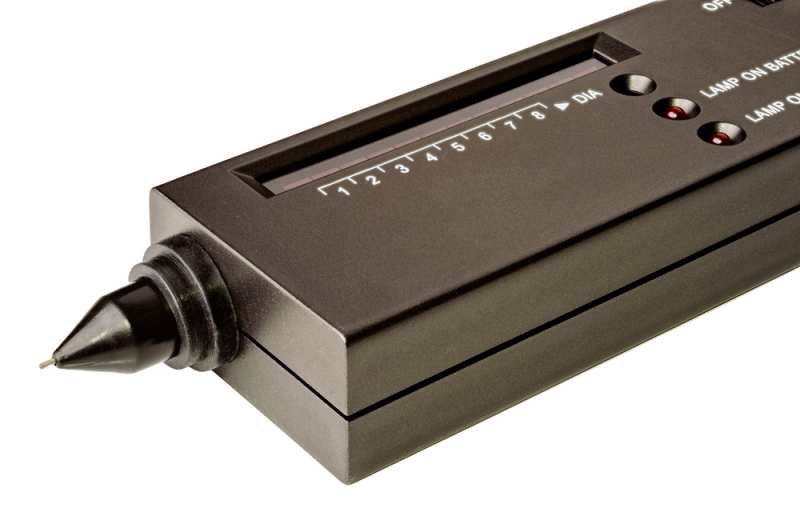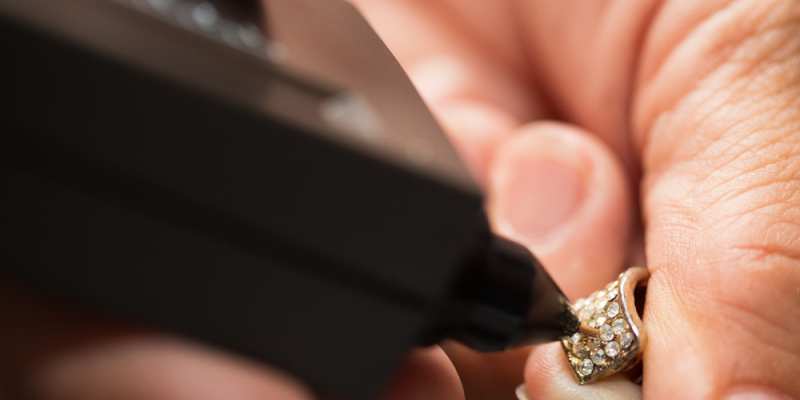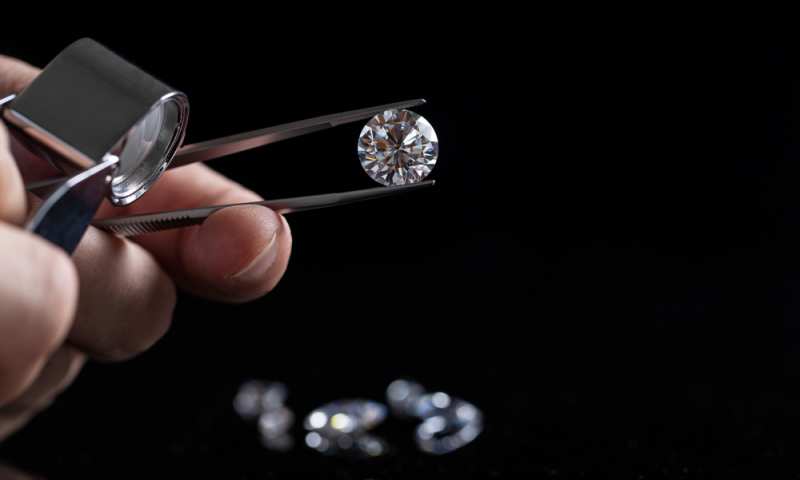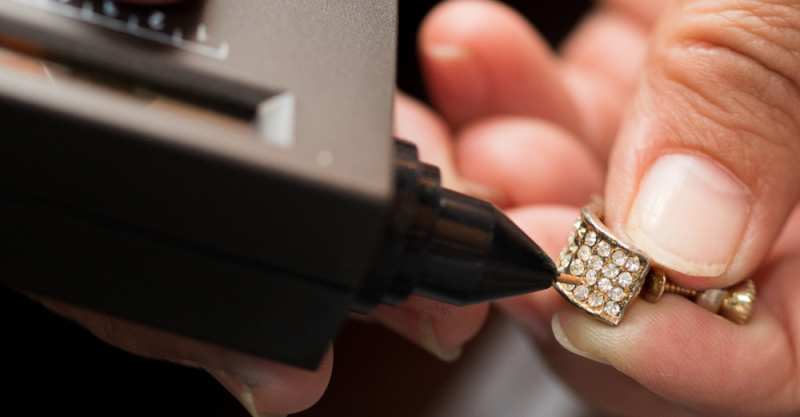Whether you are in the market to buy or sell a diamond, it is essential to ensure its authenticity and distinguish it from mere imitations. Diamond testers are commonly known as devices that can help determine if a diamond is real or not.
However, a question arises: Can diamond testers be deceived? The straightforward answer is:
Yes, certain diamond testers can be deceived, even when used correctly. However, there are types of diamond testers that are less susceptible to being fooled by fake diamonds.
In this comprehensive article, we will delve into everything you need to know about diamond testers. We will also provide you with valuable tips and tricks related to these devices. So, without any delay, let us dive right in.
DESIGN YOUR OWN ENGAGEMENT RING: START WITH A SETTING OR START WITH A DIAMOND. IT’S REALLY UP TO YOU!

Never Heard About Diamond Testers?
As we progress further into the 21st century, technology continues to advance, making it easier to create highly realistic imitations. Many of these imitations can deceive even the most knowledgeable experts without the aid of specialized devices.
This is where diamond testers come into play. They serve the purpose of distinguishing genuine gemstones from fake ones.
Given the rapid advancements in methods and materials in this field, it is advisable to use one of the latest models of diamond testers. By doing so, you can ensure accurate authenticity readings.
Diamond testers are sometimes referred to as diamond testing pens by jewelers, owing to their design.
When should you use a diamond tester?
If you are buying, selling, repairing, or loaning diamond jewelry, you will likely encounter diamond testers.
Buying: When purchasing a diamond, it is worthwhile to request that the jeweler test the stones in your presence. This ensures that you are acquiring genuine diamonds rather than visually appealing fakes.
Selling or Loaning: If you intend to sell or loan a diamond, the standard practice for dealers is to use these devices to authenticate the diamond’s quality before making an offer.
Repairing: It is advisable to have the jeweler test the repaired diamond in front of you when you come to pick it up. Most jewelers will be happy to do this as part of their service, and it provides peace of mind since diamond switching is a genuine risk.
Learn More: How Can You Prevent Diamond Switching at the Jeweler?
Are diamond testers reliable?
It is not uncommon for laboratories to utilize diamond pen-type testers, as they can effectively distinguish certain imitations from genuine diamonds. However, even these testers must be used with extreme caution.
Pen-type testers are divided into three types: thermal conductivity testers, electric conductivity testers, and multi-type testers. The earliest testers were thermal conductivity testers, designed to separate diamonds from the most common imitation of that time, cubic zirconia.
Under ideal conditions and proper usage, these testers would produce audio and visual signals indicating a “pass” or “fail” result for diamond authenticity.
However, newer types of synthetic crystals, moissanite, certain rough rocks, and all lab-grown diamonds can easily deceive thermal testers. These testers may mistakenly identify other materials as diamonds due to similar thermal conductivity properties.
Electric conductivity testers and multi-testers are slightly more advanced and are generally used to distinguish diamonds from moissanite. Most diamonds have lower electrical conductivity than moissanite. However, it is important to note that both mined and lab-grown diamonds can fall within the same range as moissanite on certain testers due to specific trace elements. Sensitivity and calibration of these devices can often change over time.
Despite the marketing claims of these technologies, we have witnessed instances where moissanite samples pass as diamonds on certain electrical conductivity testers. Additionally, readings from multi-testers and thermal testers can fluctuate due to minor changes in surrounding conditions, such as accidental contact with foreign surfaces or variations in probe pressure against the tested material.
There are several factors that can disrupt the performance of these tests, so miscalibration is something to be cautious of when using these devices.
Lab-grown diamonds, which are also made of pure carbon, will register as “real diamonds” when tested with an electro-thermal conductivity tester. Therefore, this test alone cannot differentiate between synthetic and natural diamonds.
While diamond testers can be a helpful secondary test in gemology, gemologists generally do not rely solely on the results of these tests. They are typically used as screening tests to eliminate known diamond imitations.
When conducted properly, these tests can provide supportive information. However, some sellers may employ tricks to intentionally alter the readings of a diamond tester.
The internal wiring of many pen-type testers is sensitive and can change over time. They can also be
disassembled and manipulated to reflect higher sensitivity than recommended, resulting in manual calibrations being adjusted incorrectly.
Certain diamond sellers have identified flaws in specific diamond tester units, allowing them to exploit pressure differences to their advantage. For example, applying more or less pressure can sometimes affect the resulting verdict.
If you have no other means of testing a gemstone, using an electronic diamond tester properly is still much better than making an uninformed guess. However, it is important to acknowledge that these devices may not provide 100% consistent results every time.
For stones mounted on jewelry, pen-type testers may be the only applicable test in certain situations. Nonetheless, it is crucial to remember that there will always be gemstones that do not conform to the expected results.
We cannot emphasize enough that multiple tests should be considered to avoid costly mistakes. Each type of test has its own unique limitations, and overlooking them can lead to errors. If you are unsure about the accuracy of your tester readings, it is advisable to take the stone to a gemological lab, where experts can provide you with the correct answer.

How Do Diamond Testers Work?
Diamond testers employ a needle placed on top of the device to determine the authenticity of a diamond. This needle operates based on thermal conductivity to provide a reading.
By analyzing the rate at which heat travels through the gemstone being tested, the tester can determine if the gem is genuine or not.
Some testers evaluate the electrical conductivity of the gemstone using similar principles, but they focus on electrical rather than thermal conductivity.
Learn More: How Does a Diamond Tester Work? – In-Depth Explanation of a Device for Authenticating Diamonds
How to Use a Diamond Tester?
Using a diamond tester is relatively straightforward once you grasp the basics. Make sure to consult your model’s instructions to interpret the readings correctly.
Here are some helpful tips to remember:
- Ensure that the gemstone is clean before testing.
- Avoid applying excessive pressure on the diamond tester tip, as it can damage or break.
- Press the tip onto the gem at a minimum 90-degree angle.
- When testing a stone set in jewelry, ensure the tip touches the stone itself and not the surrounding metal.
- It’s best to use a neutral testing base when examining loose stones.
Learn More: What Happens When a Diamond Tester Beeps?
Useful Features in Diamond Testers
If you’re in the market for a diamond tester, it’s worth considering some beneficial additional features that your chosen model may offer.
Retractable Tip:
Look for a diamond tester with a retractable tip. This feature protects the delicate tip and ensures you apply the appropriate amount of pressure to the gemstone’s surface during testing. It also reduces the need for frequent replacements or repairs.
Quick Temperature Reach:
Traditional diamond testers differentiate diamonds from other stones by measuring thermal conductivity. The tester’s tip heats up and is then placed against the cooler surface of the gemstone being tested. The heat transfer process provides thermal conductivity readings. Opt for a tester that reliably and rapidly reaches and returns to the testing temperature, allowing you to perform multiple tests without interference from previous readings.
Ability to Differentiate Between Metal and Gemstones:
Since you may test gemstones already set in jewelry, it’s important for your diamond tester to distinguish between accurately placing the tip on the gemstone and accidentally touching the surrounding metal. Lower-quality testers may lack this feature, leading to inaccurate readings.
See Also: Is Diamond a Metal or Non-Metal? Is It a Rock or a Stone?
Accurate Performance in Varying Ambient Temperatures:
Diamond testers rely on testing thermal conductivity to differentiate real diamonds from fakes. To ensure accurate results, choose a high-quality tester that can handle changes in ambient temperature without confusion.
Battery or Mains Powered:
Cordless, battery-powered diamond testers offer more flexibility, but you may also want the option to connect your tester to a power source. Some models provide both battery and mains power options, so consider this when reviewing product specifications.

Alternative Ways To Check Diamond Without Tester
Let’s discuss several home tests you can perform to determine if you have a genuine diamond in your possession.
Fog Test:
Hold the diamond in front of your mouth and exhale onto it. If the stone remains foggy for more than a few seconds, it is likely a fake. Real diamonds disperse heat quickly and clear up the fog immediately.
Water Test:
Fill a glass with water and carefully place your gemstone into it. Real diamonds are dense, so they will sink to the bottom of the glass. If the gemstone floats or sinks only slightly, it is likely a fake.
Dot Test:
Draw a small dot on a piece of blank paper. Place your gemstone on top of the dot, stand up, and look down through the stone at the dot. Genuine diamonds refract light, so the stone should refract the reflection of the dot.
While these simple tests can provide some insight into the authenticity of your gemstone, it is advisable to invest in a proper diamond tester for more accurate readings.

Bottom Line
Let’s address the question of whether diamond testers can be fooled once and for all:
While pen-type diamond testers serve as useful secondary tests, gemologists do not solely rely on them due to the potential for being deceived. These testers have not consistently provided reliable results, leading to a lack of confidence in their accuracy.
However, diamond testers are still valuable tools for screening known imitations and are commonly used when buying, selling, loaning, or repairing diamonds.
Diamond testers operate by measuring either thermal conductivity or electrical conductivity of the gemstone. To obtain precise readings with a diamond tester, it is important to clean the diamond thoroughly, apply the correct pressure on the tester’s tip, and ensure the tip is pressed at a 90-degree angle to the gemstone.
Some diamond testers come with additional features such as a retractable tip or the ability to differentiate between the metal and the gemstone. It is recommended to consider these features when selecting a diamond tester.
If you have doubts about the accuracy of your tester’s readings, it is advisable to have your gemstone examined by a professional gemological lab for a more comprehensive evaluation.


